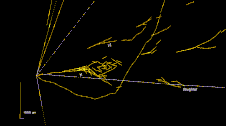INDUSTRY
OPERA collaboration presents results on neutrino oscillations

The OPERA experiment, located at the Gran Sasso Laboratory of the Italian National Institute for Nuclear Physics (INFN), was designed to conclusively prove that muon-neutrinos can convert to tau-neutrinos, through a process called neutrino oscillation, whose discovery was awarded the 2015 Nobel Physics Prize. In a paper published yesterday in the journal Physical Review Letters, the OPERA collaboration reports the observation of a total of 10 candidate events for a muon to tau-neutrino conversion, in what are the very final results of the experiment. This demonstrates unambiguously that muon neutrinos oscillate into tau neutrinos on their way from CERN, where muon neutrinos were produced, to the Gran Sasso Laboratory 730km away, where OPERA detected the ten tau neutrino candidates.
The OPERA collaboration has also made their data public through the CERN Open Data Portal. By releasing the data into the public domain, researchers outside the OPERA Collaboration have the opportunity to conduct novel research with them. The datasets provided come with rich context information to help interpret the data, also for educational use. A visualizer enables users to see the different events and download them. This is the first non-LHC data release through the CERN Open Data portal, a service launched in 2014.
There are three kinds of neutrinos in nature: electron, muon and tau neutrinos. They can be distinguished by the property that, when interacting with matter, they typically convert into the electrically charged lepton carrying their name: electron, muon and tau leptons. It is these leptons that are seen by detectors, such as the OPERA detector, unique in its capability of observing all three. Experiments carried out around the turn of the millennium showed that muon neutrinos, after traveling long distances, create fewer muons than expected, when interacting with a detector. This suggested that muon neutrinos were oscillating into other types of neutrinos. Since there was no change in the number of detected electrons, physicists suggested that muon neutrinos were primarily oscillating into tau neutrinos. This has now been unambiguously confirmed by OPERA, through the direct observation of tau neutrinos appearing hundreds of kilometers away from the muon neutrino source. The clarification of the oscillation patterns of neutrinos sheds light on some of the properties of these mysterious particles, such as their mass.
The OPERA collaboration observed the first tau-lepton event (evidence of muon-neutrino oscillation) in 2010, followed by four additional events reported between 2012 and 2015, when the discovery of tau neutrino appearance was first assessed. Thanks to a new analysis strategy applied to the full data sample collected between 2008 and 2012 – the period of neutrino production - a total of 10 candidate events have now been identified, with an extremely high level of significance.
“We have analyzed everything with a completely new strategy, taking into account the peculiar features of the events,” said Giovanni De Lellis Spokesperson for the OPERA collaboration. “We also report the first direct observation of the tau neutrino lepton number, the parameter that discriminates neutrinos from their antimatter counterpart, antineutrinos. It is extremely gratifying to see today that our legacy results largely exceed the level of confidence we had envisaged in the experiment proposal.”
Beyond the contribution of the experiment to a better understanding of the way neutrinos behave, the development of new technologies is also part of the legacy of OPERA. The collaboration was the first to develop fully automated, high-speed readout technologies with sub-micrometric accuracy, which pioneered the large-scale use of the so-called nuclear emulsion films to record particle tracks. Nuclear emulsion technology finds applications in a wide range of other scientific areas from dark matter search to volcano and glacier investigation. It is also applied to optimise the hadron therapy for cancer treatment and was recently used to map out the interior of the Great Pyramid, one of the oldest and largest monuments on Earth, built during the dynasty of the pharaoh Khufu, also known as Cheops.
